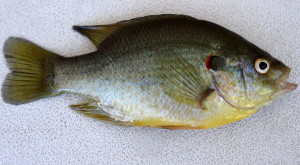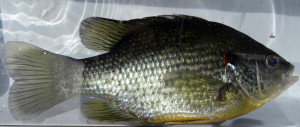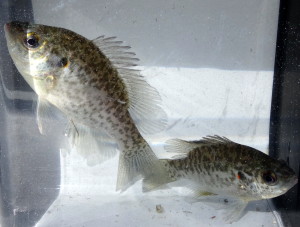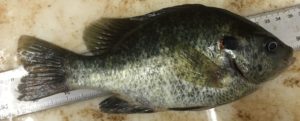Redear Sunfish (Lepomis microlophus)
Common Names: Shellcracker, Sun perch, Cherrygill, sunny



Range: Redear sunfish are found throughout the southeastern United States, as far west as Texas and as far north as Indiana. They have been introduced in several states from California to Vermont.
Description: Redear sunfish have a dark olive compressed body, fading to light green and silver on the sides with dark spots and sometimes stripes, often seen on younger fish. They have a small mouth, and their ear flaps have a white rim surrounding them with a red-orange spot on tip, giving the Redear sunfish their name. The pectoral fins are long and pointed.
Biology and Life History: Redear sunfish reside on the bottoms of ponds, lakes and reservoirs, preferring habitats with little current and abundant vegetation. Redear sunfish spawn at cooler temperatures, and males construct nests in water deeper than 3 feet often in colonies on the pond bottom. They feed on snails and small mollusks, but will also prey upon small insect larvae and large zooplankton. They are bottom feeders and therefore are less likely to consume commercial fish feeds. They are considered to be a sportfish. Redears reach sexual maturity at 2 years of age and do not live past six years old. They can grow up to 12 inches and weigh as much as 2 pounds.
Stocking: Redear sunfish are often stocked in combination with blue gill, as they do not provide forage for larger fish but prey upon snails, thus reducing the incidence of snail-borne fish parasites. They make excellent forage for largemouth bass. It is recommended to stock 250 Redear fingerlings around 1 to 3 inches long per acre in late summer or early fall.
Adapted From:

